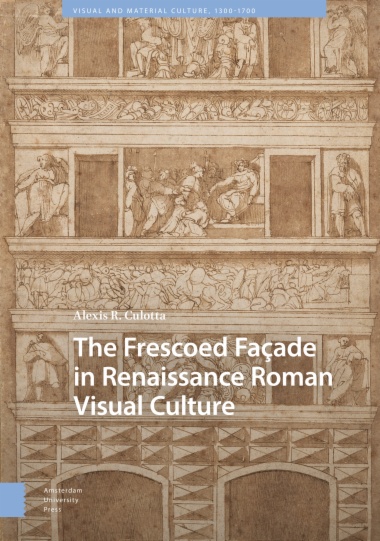This book examines Roman façades decorated with fresco and sgraffito between the fifteenth and sixteenth centuries that once enveloped the central rioni of Rome within a web of symbolic social, political, and familial allegiances that transformed a street-side stroll into a visually engaging experience. Today, many of these faces are lost, and our understanding of what they comprised is frighteningly incomplete. This book offers a refreshed look at this often-forgotten facet of Renaissance visual culture to reignite interest in the tradition before its last remnants disappear. In addition to offering a new compilation of these documented façades, this book also places new emphasis on the making and meaning of these “painted faces” to provide new insights into the place of the decorated façade at the intersections of patron identity and painterly innovation in a city working tirelessly to reinvent itself.
- Cover
- Table of Contents
- Acknowledgements
- Introduction
- 1. Foundations: First Style (Structural)
- 2. Theoretical Implications: Second Style (Framed)
- 3. Increasing Innovation: Third Style (Illusory)
- 4. Total Translation: Fourth Style (Theatrical)
- 5. Contextual Conversations
- Conclusion: Beyond Renaissance Rome
- Appendix: Façade Inventory
- List of Works Cited
- Index
- List of Illustrations
- Fig. 1: Fragmentary façade decorations visible on the home at vicolo Sugarelli, 1–2 (photo: Valeria Castiello, 2023).
- Fig. 2: Enrico Maccari, “Graffito Esistente in Roma al Vicolo Sugarelli, No. 1,” showcasing additional insights into the remaining fragments at this property address today (fig. 1). As illustrated in: Maccari and Iannoni, Graffiti e chiaroscuri, table 11.
- Fig. 3: Map of the roughly 200 documented decorated façades dated to the fifteenth and sixteenth centuries across the center of Rome, with red overlay dots indicating surviving frescoes (author’s illustration/ArcGIS).
- Fig. 4: Works of Sixtus V: Antoninus Column, ca. 1590; fresco; vault of the Sistine Library. Getty Images/Di Agostini Picture Library. A close look to the right of the triumphal column reveals the Arco dei Pazzarelli, reported by Mancini as being frescoed
- FIG 5: Antonio Lafreri and Hieronymus Cock, after Martin van Heemskerck, Della Valle Museum, from “Speculum Romanae Magnificentiae,” sixteenth century; Metropolitan Museum of Art, acc. no. 41.72(2.137). Image in the public domain.
- Fig. 6: Views of the casina Bessarione (via di Porta San Sebastiano, 5). While the interior garden loggia (right) depicts expansive fictive landscapes, its exterior façade features imposing faux opus quadratum capped with weathered remnants of an all’anti
- Fig. 7: The façade of the “Albergo dell’Orso” (on the façade along via dei Soldati, 25). Though technically a second-style façade, owing to the large crest (partially visible below the lower entablature, to the left of the three windows on the second leve
- Fig. 8: The open-air loggia of the casa dei Cavalieri di Rodi, showing a small portion of the fictive restored opus quadratum on the exterior at the upper right corner (photo: author, 2024).
- Fig. 9: Façade of vicolo del Governo Vecchio, 52, at the intersection with vicolo dell’Arco di Chiesa Nuova (photo: Valeria Castiello, 2023).
- Fig. 10: Detail of the façade at vicolo del Moro, 62 (photo: Valeria Castiello, 2023).
- Fig. 11: The façade of the “casa Muti,” via dei Cappellari, 61–62 (photo: Valeria Castiello, 2023).
- Fig. 12: The façade of the palazzo Mattei in piazza Piscinula. Fictive ashlars can be spotted below the roof, and the central zone of the façade still bears evidence of sgraffito (photo: Valeria Castiello, 2023).
- Fig. 13: Enrico Maccari, “Fregio che ha esisto in Roma al vicolo dei Spagnuoli, No. 39–40, Fino a tutto l’anno 1866; Fregio chiaroscuro esistente in Roma in via Banchi Vecchi, 89–90.” As illustrated in: Maccari and Iannoni, Graffiti e chiaroscuri, table 1
- Fig. 14: The façade of the casa Amedei (via della Fossa, 14a–17) with some evidence of the modified window frame all’antica stringcourse on the second level (photo: Valeria Castiello, 2023).
- Fig. 15: Enrico Maccari, “Graffito Esistente in Roma in via Tomacelli, No. 103–104; Graffito esistente in Roma al vicolo Cellini, già Calabragha, No. 31–32.” As illustrated in: Maccari and Iannoni, Graffiti e chiaroscuri, table 34.
- Fig. 16: Composite views of the palazzo dei Millini, from left to right: a detail view of the sgraffito additions within the tower crenellations; what remains of a once colorful stemma roundel and a street-level view of the palazzo and tower, where both t
- Fig. 17: Francesco di Giorgio, Ideal Architectural Veduta, ca. 1490; oil on panel; 233 × 131 cm; Staatliches Museen, Berlin, inv. no. 1615. Image in the public domain.
- Fig. 18: The façade at via del Pellegrino, 64–65, the “Albergo Tre Rè” (photo: Valeria Castiello, 2023).
- Fig. 19: The façade at via dei Banchi Nuovi, 15a–16 (photo: author, 2024).
- Fig. 20: Enrico Maccari, “Graffito di proprietà Spagnuola esistente in Roma al vicolo della Barchetta, No. 2,3,4.” As illustrated in: Maccari and Iannoni, Graffiti e chiaroscuri, table 23.
- Fig. 21: The façade of via dei Giubbonari, 46–47 (photo: Valeria Castiello, 2023).
- Fig. 22: Views of the overall façade of the home of Pietro Paolo della Zecca (via del Banchi Vecchi, 148) that detail fresco remains showcasing hints of fictive architecture, faux marble, and portions of the stemma of the Holy Roman Emperor (photo: Alessi
- Fig. 23: Baldassare Peruzzi (attributed), Preparatory Sketch of Caesar and Augustus for the Frescoes of Palazzo Buzio; brown pen, red chalk, partially covered in white; 27.9 × 21 cm; Kunstsammlungen der Veste Coburg, inv. no. Z.2424.
- Fig. 24: Marcantonio Raimondi, Quos Ego, 1515–16; Musée des Beaux-Arts de la Ville de Paris. Petit Palais/PWB Images/Alamy Stock Photo.
- Fig. 25: Detail of the palazzo Lancellotti (via Maschera d’Oro façade), revealing the depth of incision involved in sgraffito additions (photo: Valeria Castiello, 2023).
- Fig. 26: The façade of the casa Sander, via Santa Maria dell’Anima, 65 (photo: Valeria Castiello, 2023).
- Fig. 27: The façade of the palazzo Massimo Istoriato that faces the piazza dei Massimi (photo: Valeria Castiello, 2023).
- Fig. 28: Enrico Maccari, “Graffito esistente in Roma al vicolo del Campanile, No. 4.” As illustrated in: Maccari and Iannoni, Graffiti e chiaroscuri, table 24.
- Fig. 29: The façade of the palazzetto Spoleto (piazza san Eustachio, 53) (photo: Valeria Castiello, 2023).
- Fig. 30: The L-shaped façade of the palazzo Ricci (photo: author, 2023).
- Fig. 31: Enrico Maccari, “Chiaroscuro celebre esistente in Roma in via della Maschera d’Oro, No. 7.” As illustrated in: Maccari and Iannoni, Graffiti e chiaroscuri, table 38.
- Fig. 32: Detail view of the façade of the Palazzo Milesi (via Maschera d’Oro, 7) showcasing the use of chiaroscuro di terretta (photo: Alessio Fioretti, 2024).
- Fig. 33: The façade of the casa Lancia (via San Salvatore in Campo, 43–44) (photo: Valeria Castiello, 2023).
- Fig. 34: Author’s table of the two main “generations” of frescoed façade artists, in production order.
- Fig. 35: Vincenzo Tamagni, Sheet of Figure Studies and Ornamental Motifs, ca. 1520–30; Metropolitan Museum of Art, acc. no. 2001.156.3. Image in the public domain.
- Fig. 36: The façade at via del Pellegrino, 66–67 (photo: Valeria Castiello, 2023).
- Fig. 37: Anonymous, Copy of the Façade Decoration of Palazzo Gaddi in Rome (later Palazzo Cesi), ca. sixteenth century; Albertina, Austria. Image in the public domain.
- Fig. 38: Anonymous, Equestrian Portrait of Matthias Corvinus, first half of the seventeenth century; pen and watercolor; 37.6 × 28.2 cm; Biblioteca Apostolica Vaticana, Barb. Lat. 4423, fol. 73r.
- Fig. 39: Federico Zuccaro, Taddeo Drawing after the Antique; In the Background Copying a Façade by Polidoro, ca. 1595; pen and brown ink, brush with brown wash over black chalk and touches of red chalk; 42.3 × 17.5 cm. Digital image courtesy of Getty’s Op
- Fig. 40: Anonymous artist, reverse copy after Cherubino Alberti, after Polidoro da Caravaggio, Vessel with grotesque masks, griffins, and a frieze populated by a bull and men in bas-relief, ca. 1550–1600; Metropolitan Museum of Art, acc. no. 2012.136.122.

